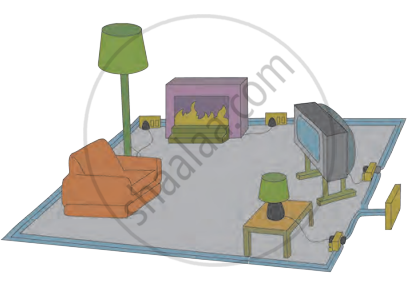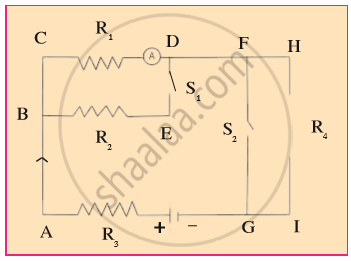Advertisements
Online Mock Tests
Chapters
2: Work and Energy
▶ 3: Current Electricity
4: Measurement of Matter
5: Acids, Bases and Salts
6: Classification of Plants
7: Energy Flow in an Ecosystem
8: Useful and Harmful Microbes
9: Environmental Management
10: Information Communication Technology (ICT)
11: Reflection of Light
12: Study of Sound
13: Carbon: An important element
14: Substances in Common Use
15: Life Processes in Living Organisms
16: Heredity and Variation
17: Introduction to Biotechnology
18: Observing Space: Telescopes
![Balbharati solutions for Science and Technology [English] 9 Standard Maharashtra State Board chapter 3 - Current Electricity Balbharati solutions for Science and Technology [English] 9 Standard Maharashtra State Board chapter 3 - Current Electricity - Shaalaa.com](/images/science-and-technology-english-9-standard-maharashtra-state-board_6:5c9e2db8f20741f3a9290526164f2c03.jpg)
Advertisements
Solutions for Chapter 3: Current Electricity
Below listed, you can find solutions for Chapter 3 of Maharashtra State Board Balbharati for Science and Technology [English] 9 Standard Maharashtra State Board.
Balbharati solutions for Science and Technology [English] 9 Standard Maharashtra State Board 3 Current Electricity Exercise [Pages 44 - 45]
The accompanying figure shows some electrical appliances connected in a circuit in a house. Answer the following questions.
- By which method are the appliances connected?
- What must be the potential difference across individual appliances?
- Will the current passing through each appliance be the same? Justify your answer.
- Why are the domestic appliances connected in this way?
- If the T.V. stops working, will the other appliances also stop working? Explain your answer.

The following figure shows the symbols for components used in the accompanying electrical circuit. Place them at proper places and complete the circuit.

Which law can you prove with the help of above circuit?
Umesh has two bulbs having resistances of 15Ω and 30Ω. He wants to connect them in a circuit, but if he connects them one at a time the filament gets burnt. Answer the following.
- Which method should he use to connect the bulbs?
- What are the characteristics of this way of connecting the bulbs depending on the answer of A above?
- What will be the effective resistance in the above circuit?
The following table shows the current in Amperes and potential differences in Volts.
- Find the average resistance.
- What will be the nature of the graph between the current and potential difference? (Do not draw a graph.)
- Which law will the graph prove? Explain the law.
| V (volts) | I (amp) |
| 4 | 9 |
| 5 | 11.25 |
| 6 | 13.5 |
Match the pairs.
| ‘A’ Group | ‘B’ Group |
| 1. Free electrons | a. V/R |
| 2. Current | b. Increases the resistance in the circuit |
| 3. Resistivity | c. Weakly attached |
| 4. Resistances in series | d. VA/LI |
The resistance of a conductor of length x is r. If its area of cross-section is a, what is its resistivity? What is its unit?
Resistances R1, R2, R3 and R4 are connected as shown in the figure. S1 and S2 are two keys. Discuss the current flowing in the circuit in the following cases.

- Both S1 and S2 are closed.
- Both S1 and S2 are open.
- S1 is closed but S2 is open.
Three resistances x1, x2, and x3 are connected in a circuit in different ways. x is the effective resistance. The properties observed for these different ways of connecting x1, x2 and x3 are given below. Write the way in which they are connected in each case. (I-current, V-potential difference, x-effective resistance)
- Current I flows through x1, x2 and x3
- x is larger than x1, x2 and x3
- x is smaller than x1, x2 and x3
- The potential difference across x1, x2 and x3 is the same
- x = x1 + x2 + x3
- x = `1/(1/X_1 + 1/X_2 + 1/X_3)`
Solve the following problems.
The resistance of a 1m long nichrome wire is 6 ohm. If we reduce the length of the wire to 70 cm. what will its resistance be?
When two resistors are connected in series, their effective resistance is 80 Ω. When they are connected in parallel, their effective resistance is 20 Ω. What are the values of the two resistances?
If a charge of 420 C flows through a conducting wire in 5 minutes what is the value of the current?
Solutions for 3: Current Electricity
![Balbharati solutions for Science and Technology [English] 9 Standard Maharashtra State Board chapter 3 - Current Electricity Balbharati solutions for Science and Technology [English] 9 Standard Maharashtra State Board chapter 3 - Current Electricity - Shaalaa.com](/images/science-and-technology-english-9-standard-maharashtra-state-board_6:5c9e2db8f20741f3a9290526164f2c03.jpg)
Balbharati solutions for Science and Technology [English] 9 Standard Maharashtra State Board chapter 3 - Current Electricity
Shaalaa.com has the Maharashtra State Board Mathematics Science and Technology [English] 9 Standard Maharashtra State Board Maharashtra State Board solutions in a manner that help students grasp basic concepts better and faster. The detailed, step-by-step solutions will help you understand the concepts better and clarify any confusion. Balbharati solutions for Mathematics Science and Technology [English] 9 Standard Maharashtra State Board Maharashtra State Board 3 (Current Electricity) include all questions with answers and detailed explanations. This will clear students' doubts about questions and improve their application skills while preparing for board exams.
Further, we at Shaalaa.com provide such solutions so students can prepare for written exams. Balbharati textbook solutions can be a core help for self-study and provide excellent self-help guidance for students.
Concepts covered in Science and Technology [English] 9 Standard Maharashtra State Board chapter 3 Current Electricity are Potential and Potential Difference, Electric Current, Precautions to Be Taken While Using Electricity, Electricity, Ohm's Law (V = IR), Electric Circuit, Free Electrons, Resistance and Resistivity of a Conductor, Symbols and Functions of Various Components of an Electric Circuits, Conductors and Insulators, Domestic Electrical Connections, System of Resistors, Resistors in Series, Resistors in Parallel, Experimental Verification of Ohm’s Law.
Using Balbharati Science and Technology [English] 9 Standard Maharashtra State Board solutions Current Electricity exercise by students is an easy way to prepare for the exams, as they involve solutions arranged chapter-wise and also page-wise. The questions involved in Balbharati Solutions are essential questions that can be asked in the final exam. Maximum Maharashtra State Board Science and Technology [English] 9 Standard Maharashtra State Board students prefer Balbharati Textbook Solutions to score more in exams.
Get the free view of Chapter 3, Current Electricity Science and Technology [English] 9 Standard Maharashtra State Board additional questions for Mathematics Science and Technology [English] 9 Standard Maharashtra State Board Maharashtra State Board, and you can use Shaalaa.com to keep it handy for your exam preparation.
